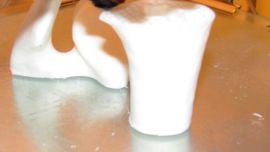Five months ahead of crucial midterm elections in Argentina, the peso has become the cornerstone of Javier Milei’s campaign strategy.
The libertarian president views the currency as a key tool to lower inflation and boost his party’s chances in the October vote, instructing his aides to pursue bold measures that will drive up the value of the peso.
Milei in recent weeks unveiled a band in which the peso will trade after partially lifting currency controls for individuals. Since April 14, the currency has traded below the midpoint of the band – set initially between 1,000 and 1,400 pesos per US dollar before widening by one percent a month in either direction – limiting depreciation and the pass-through of inflation that analysts had predicted.
“The model of a miserable Argentina, given away in dollars, is over,” Economy Minister Luis Caputo said last week at a meeting with business leaders.
A stronger peso could fuel optimism among Argentines about the economic outlook. On the flip side, it could also hurt margins and competitiveness, said Alejandro Cuadrado, global head of currency strategy for Latin America at BBVA. “The peso had already appreciated in real terms, so strengthening it would deepen that trend,” he said.
Here’s how Milei’s government plans to strengthen the peso further.
1. Seasonal soy exports
The soybean harvest usually generates a flood of dollars during the second quarter. Add to that the expiry of a tax exemption on agricultural exports, which will end June 30, nudging soybean producers and exporters to sell dollars, in line with Milei’s goal.
2. Bonds for dollar holders
Argentina’s Central Bank is working on issuing peso-denominated bonds that can be purchased in dollars, Federico Furiase, one of the bank’s directors, said in a television interview last week. The initiative is aimed at helping the monetary authority accumulate reserves, Furiase said.
3. The carry trade
A recent regulatory change allows foreign investors to participate in the official exchange market as long as they keep their investments in Argentina for six months or longer. That’s attracting overseas money from investors looking to take advantage of the carry trade, a popular strategy that involves betting on returns in pesos amid a stable or appreciating exchange rate.
4. Amnesty for savers
Caputo plans to encourage Argentines to bank nearly US$200 billion currently stored outside of the financial system. The economy minister wants to channel these savings into everyday transactions and monetise economic activity in dollars as the government seeks to limit the amount of pesos in circulation. Milei’s chief spokesman Tuesday said more details would be provided on Thursday.
5. Energy exports
Energy exports, which have increased significantly in recent years, promise to become the country’s second largest source of foreign exchange, behind agriculture. Key to that will be Vaca Muerta, the country’s main oil field.
6. Foreign direct investment
The government expects the supply of dollars to increase after the lifting of exchange controls. The thinking goes that companies will be tempted to bring dollars into the country if they are free to sell them on the foreign exchange market when they want. The so-called ‘RIGI’ programme adds to that by granting concessions for large investments. However, foreign investment has largely been absent during Milei’s Presidency as portfolio managers remain cautious.
7. Fiscal surplus
Argentina’s Treasury plans to maintain a fiscal surplus and withdraw pesos from the market, Furiase said last week. Fewer pesos in the system will limit demand for dollars and ease pressure on the exchange rate.
8. Peso vacuum
The Central Bank’s decision not to buy dollars until the peso strengthens is sending a signal that policymakers won’t inject pesos in the system. The Central Bank also announced it will issue a dollar-denominated bond – which can be purchased in pesos – for companies that need to send dividends abroad. This would be separate from Argentina’s treasury auction of peso-linked notes.
The implementation of these tools would reinforce the government’s commitment to maintaining the strength of the peso. Argentina’s currency, dubbed “excrement” by Milei during the 2023 election campaign, ranked among the world’s top-performing currencies in 2024 – after adjusting for inflation – and stands at its strongest level in 10 years, according to the Central Bank.
But, a continuously stronger currency doesn’t come without risks. The lower limit of the peso’s band should not be sought, given the targets that Argentina has to hit as part of its financing agreement with the International Monetary Fund and ahead of a potentially less favorable environment in the second half of the year, BBVA’s Cuadrado said.
Aimed at boosting the purchasing power of Argentine wages in dollars and in real terms – and winning voters ahead of the October elections – some fear that the strengthening peso could dampen activity in some sectors, or boost devaluation expectations.
“This could create a window of opportunity to buy dollars,” said Federico Filippini, chief economist at Adcap, an investment manager. “But as long as the government remains focused on its inflation target, this will be sustainable,” Filippini said.
Business leaders on Tuesday called for tax cuts at an event in Buenos Aires. “You can’t have all the variables working against you. The burden of withheld taxes, the strong exchange rate, and a whole set of adverse factors are holding back many sectors,” said Manuel Santos Uribelarrea, CEO of electricity generator MSU.
related news
by Ignacio Olivera Doll, Bloomberg




















Comments